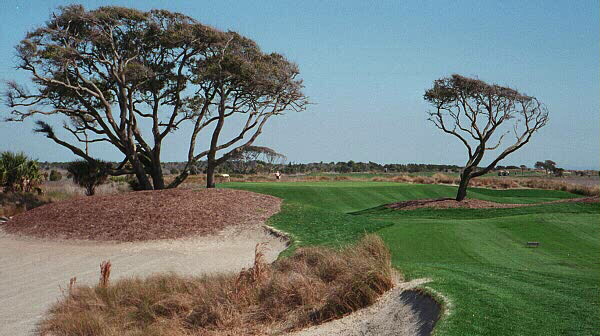Feature Interview with Pete Dye
December 2000
1. What courses that you played as a youth had the biggest influence on your design career?
Urbana Country Club, Urbana, Ohio.
2. What specific design features impressed you the most from your 1960s trip to Scotland?
Maintenance & the variety of grasses.
3. Many consider the low profile The Golf Club and Casa de Campo Cajuiles Course as your two finest designs. Can you contemplate returning to that design style in the future?
Thought I had.
4. How is your design influenced when you build a course knowing that it will host major tournaments ala TPC Stadium Course at Sawgrass?
Gallery-Gallery-Gallery.
5. Please describe the evolution of the course at Crooked Stick and the reasons for the various changes.
Maintenance – New bents – General thinking how PGA Tour & USGA changed – Maintenance.
6. Many of your courses feature a par 5-par-3-par 4 finish. At what point did you come to view this as the ideal finish?
Gives good possiblity for variety.
7. What are your current projects?
4th course at Casa de Campo. I think the new course at the PGA Village in Port St. Lucie is one of my best. I have no idea how it will be rated or if it will even be rated!
8. A large percentage of today’s top younger architects (Bill Coore, Tom Doak, Tim Liddy, John Harbottle, Rod Whitman, Lee Schmidt and others) worked for you at one point. Is there any one thing that you try and instill in your design associates?
They could draw – I never have had to.
9. How do Alice and you work together? How would your designs be different if it were not for your wife’s influence?
Alice is a great player – Seen the change in thinking of the USGA and PGA Tour from both men and ladies point of view.
10. How has being very good golfers helped the design perspectives of both of you?
Imperative. Also have had the opportunity to play with all types of men and lady players with low to high handicaps on a variety of different courses.
11. After more than 35 years of designing and building courses, how do you keep coming up with fresh ideas so that your courses do not start to look alike?
Luck to find different terrain.
12. What five holes from different courses do you most wish you could say you designed?
Never gave it a thought.
13. Please select a hole that you all have built and describe why it plays equally well from the championship tees as it does from the ladies tee.
17th hole at TPC Players – short but hard for all players.
So does the 5th at Teeth of Dog.
14. What in particular do you admire about Seth Raynor’s work?
Variety.
15. How would you compare golf course architecture in the first half of the 20th century to that of the second half?
No comparison. Hand work is better than machine. Also, no comparison in government problems. Available sites were better then.

The east coast of the United States hasn’t seen a site as good as The Ocean Course at Kiawah since William Fynn re-designed Shinnecock Hills in 1930.
16. How do the advances in both equipment and turf influence your design?
Dramatically reduced contours on green. Back to front on recent greens have very little change in elevation – 6 to 8 inches.
17. You seemingly single-handedly re-introduced the short and medium length par four into the game. What inspired you to do so? Your trip to Scotland? What are your three favorite par fours under 370 yards (that you did not design)?
Always look for variety.
Never thought of it.
18. What reaction to one of your course openings surprised you the most? Pleased you the most?
Snowed day opening of University of Michigan but still played. Pete Dye Club took ten years to get it finished.
The End








